Coyote hunting is an exciting, adrenaline-filled sport that will trick you into learning a ton pro-level skills. Many who casually try it for the first time eventually find themselves spending the rest of their lives pursuing coyotes at all hours of the day, in every type of weather and deeper into the wild than they ever thought possible.
Coyote hunting costs little if you already hunt turkeys or deer. Simply buying a hand caller and learning how to make a few sounds puts you in the field with everything you’ll need. And hunting coyotes at night the first time means buying nothing more than an inexpensive than a scanning light.
This article will help you succeed, even the first time you go coyote hunting. But be warned, the first time you bag a coyote will not be the last. The thrill of calling in a coyote with sounds you made, luring it into range, and tricking it into stopping long enough for you to take your shot is just the start of your coyote hunting experience.
With no bag limits and the extended coyote hunting seasons found in most states, you will spend many weekends and weeknights outdoors and in the wild. In a year or two, you’ll have marksmanship skills, tracking capabilities, and scouting abilities, and you will be a master at surviving and hunting in the wilderness.
Coyote hunting: Tools for the first timer.
If you already hunt deer or turkey and plan to hunt during the day, it takes less than $50 to get started. Want to go hunting at night? Add another $150 for a scanning light, and your chances of success will dramatically increase.
I recommend you limit your first-year coyote hunting budget to purchasing only two simple tools, a caller and a red scanning light to mount on your rifle or shotgun. I’ll explain why these tools are the best and show you some videos to quickly learn how to use them later in the article. But, for now, we need to discuss which weapon you should use.
The best weapons for new predator hunters are an old deer rifle with a 1.5 x 3 scope or a 12 gauge shotgun. If you do not have a rifle or shotgun, then know that you don’t need to buy expensive brand names. You’re looking for rifles like Winchester and Ruger, not Benelli or Barrett.
Coyote hunting requires a level of marksmanship you can only get from a weapon you have used in the past. A field scarred .243 or dad’s old Sears Model 200 is more likely to be familiar to you. You’ve used it before. You know how to operate it safely. It has a history of dependably. It’s been someone’s trusted hunting buddy, and it deserves an extra season of use every year. So after you drop that trophy buck, give it a good cleaning and a touch of oil. The two of you still have months of coyote hunting to enjoy this year.
Coyote hunting callers for beginners.
Yes, electronic callers work and are easy to use. But you don’t need them for hunting coyotes; they are expensive and hate the cold night air. I wish someone had told me I would spend “crazy” money buying different electronic coyote hunting calls every year, only to end up with a wooden hand-held rabbit squealer years later.
Hunting coyotes with electronic callers is done by new coyote hunters mainly because of one thing; stage fright.
Come on, admit it! You’ll willingly pay hundreds of dollars for an electronic caller because, even if no one is within a mile of you on the snowiest, darkest night, you think everyone can hear you. Trust me, especially at night, and more so in the winter—no one hears you. And, oddly enough, even the most wretched sounds an untrained coyote hunter makes often plucks a coyote straight out of the woods.
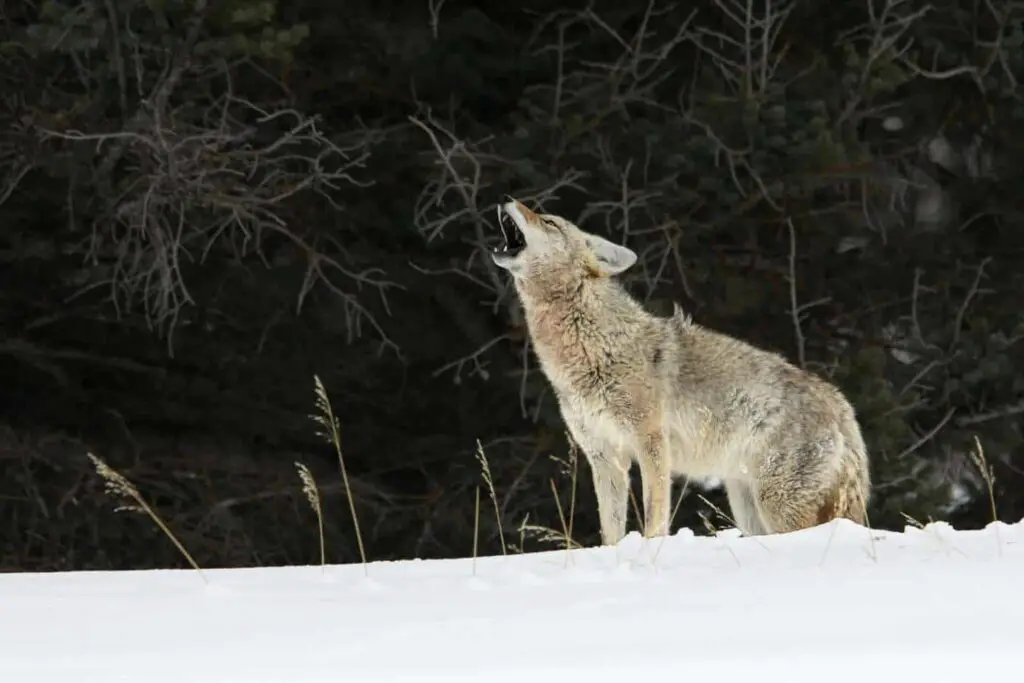
Hunting for coyotes with open and closed reed calls.
Two types of hand callers are perfect for hunting for coyotes; closed reed and open reed. I will discuss how to use the closed reed, but you can read everything you need to know about the open reed in this article: How to use an open reed caller.
Closed reed calls are simple to use because they are made with reed length preset and fixed in place by the manufacturer. This limits the number of sounds you can create and their volume, but it allows users to rapidly produce a consistent sound they can reliably use in the field.
With practice, you should be able to make the raspy whines and cries you hear in all those Youtube videos. At this point, you’re ready to begin coyote hunting. Your sound won’t be perfect like those mass-produced electronic callers, but that can be a benefit if everyone else around you is making the same darn sound. Your sound’s imperfections might just bring coyotes running to your call, dragged along like metal shavings to a magnet.
But be prepared! You must be ready to shoot the moment you make your first sound.
Interested in learning how to use a closed reed call? Then I urge you to read How to master the closed reed coyote call. Don’t worry; clicking on the link will open the article in another browser, and you won’t lose your place here. The article above features master predator hunter and call manufacturer Brian Rush. He was gracious enough to provide all the videos and tips you’ll need to start coyote hunting.
The best color of light to use when hunting for coyotes.
The leading expert on coyote vision is Mike Huff, the author of: Understanding Coyotes: The Comprehensive Guide for Hunters, Photographers and Wildlife Observers.
Before you buy a light for hunting for coyotes at night, watch his video.
Do yourself a favor, watch all of his hunting videos. Trust me, Mike Huff knows coyotes better than anyone else in the world.
I have used both red and green lights, but two things bother me about green lights.
- Green does reach out farther (using the same light and switching bulbs will prove this to you), but the light looked unnatural and felt too strong. I felt like it gave away my position.
- Green also appears to spook coyotes, at least the eastern coyotes I hunt. Many coyotes took off the second the green light swept over them, and I never had any success hunting coyotes while using green lights.
For further information on which light color to use when coyote hunting, read Coyote hunting lights: how to choose the right color.
Where can you go coyote hunting?
This is probably the most essential section of the article for many new coyote hunters. Please stick with me here; we should be able to help you find a few good spots.
Answering this question is also where you will begin learning your scouting skills. You must scout for land to hunt on and then scout that land to determine if coyotes reside there.
Public land: Coyote hunting on state and federal properties.
This number is going to sound crazy, but about 40% of all the land in the United States is ”owned” by federal or state governments. Much of this land permits appropriately licensed hunters.
You can find all of the state and federal lands in your area that allows coyote hunting by visiting Where to Hunt, selecting ”coyotes” on the species tab, and selecting the location on the map, you are interested in.
Your next step is to visit my page, Coyote hunting laws by state. Choose the state you want to hunt in and click on it. Each state page will have all the season dates and essential information you need (like whether you can hunt at night or what weapons are allowed).
Hunting public land has pros and cons, but that’s true with every place you can hunt.
Public land coyote hunters are more likely to encounter other hunters and non-hunters than those hunting private property: people jog, hike, fish, and camp on these lands—sometimes all year. Most public land users, especially when deer season is closed, will not even be aware of the sport of coyote hunting. It is your responsibility to identify your target and ensure the safety of your shot.
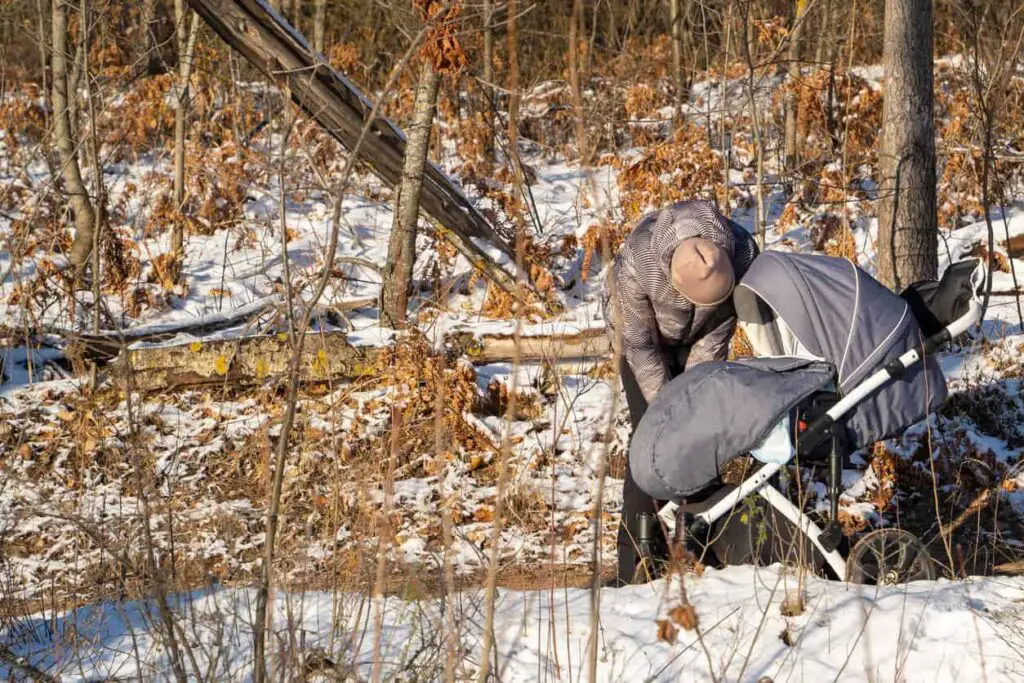
Coyote hunting on public land, especially in New York, also means finding a large and clear spot to call in coyotes. You can’t trim branches or remove obstructing shrubbery! Out west, you probably will be overcome by the sheer number of great coyote-invested hunting spots—many with excellent road access. But in the east, many of us use shotguns for coyote hunting.
Using private land when hunting for coyotes.
90% of all New Yorkers hunt (deer and predators) on private land. Yet most of us don’t own much more than a 1/4 acre—and many live in an apartment. This fact brings me to my first point: You have to ask for permission to hunt.
As a landowner, I get asked for hunting permission all the time. Do you know what always makes me laugh? The idea that the person asking me had to look up my name but never googled it. Want to guess the odds of a gun-toting, shabbily dressed group of strangers getting permission to coyote hunt my land is?
What these folks failed to do was adequately scout for private land to go hunting for coyotes on.
Gaining access to private land (other than asking your friends) requires road trips, using Google Earth, and making friends with local landowners.
Having a hunting app is invaluable. Your hunting app will show property lines and give you the owner’s contact information. Use this information to find out everything you can about the owner, their land, and what they use it for.
Types of private landowners and how to approach them for permission to hunt coyotes.
Remember the road trips I mentioned? You’ll use these for roadside scouting trips to determine how the land is used.
Ranchers. Many ranchers will allow coyote hunting. During calving season, they may even be looking for someone to kill off a few coyotes attacking their herds. Score permission to hunt and take a few outlaws off their land, and you’ll get invited back yearly.
Farmers. Some farmers believe coyotes keep the local deer population in check. They view deer grazing on their crops as a more significant hazard than coyotes. Respectfully tip your hat, and thank them for their time.
Farmers with livestock such as chickens, ducks, and geese will have a more sour opinion of coyotes. They also get many more visits from people seeking permission to hunt their land. My advice is to be the one person who clearly points out that you are not asking for permission to hunt deer. Make sure they know you want to remove the foxes and coyotes on their land. Ask if you can freely solve their problem with livestock predators; it will significantly increase your odds of success.
Hobby farmers and tractor therapy enthusiasts. I’m only half joking here. You’ll find the other two types of landowners with enough acreage to hunt on safely are folks with six chickens and a Kubota tractor in the driveway.
The only important thing to remember here is how to respond to a” No.” These landowners don’t get as many “permission to hunt” requests as ranchers and regular farmers. Some may have never even seen the coyote poop and tracks dotting their land, let alone spotted a coyote in the flesh.
Clearly and kindly thank them for their time, and then hand them your contact information. Tell them if they ever have a predator problem to give you a call. If coyotes eventually find their flocks, tangle with their dog, or a fox gets spotted carrying off a chicken; you’ll get a call. Just remember to stress your services are free.
Dress to impress when asking for coyote hunting permission.
Before approaching that door, ask yourself how you would react to a stranger asking for hunting permission. What impression are you about to make?
What does your vehicle look like? How you care for your stuff will tell landowners how you’ll treat their land.
Come alone, unarmed, and during the day. Two or more strangers will instantly make the hairs on the landowner’s back start to dance. If you come armed, you may receive a hostile response. If you come in the dark, you’ll scare the folks inside their home.
If you come in a group, armed, and at night? Expect the sheriff, state police, and game warden to be already on their way, the landowner’s dogs have surrounded your vehicle, and everyone in the house has switched off all the lights and fired up their NVGs and thermal scopes.
Expect a negative response when asking for permission to hunt.
Always expect to get a negative response the first time you ask. You must understand landowners don’t want to be sued. If they let you hunt, they own every bullet you fire. If someone gets hurt, that person will sue them. Blame society and lawyers but don’t blame the landowners who say no the first time. Just expect a no and start working on how you’ll change the owner’s mind.
If you make that first approach anticipating a refusal, your sales technique will be soft and friendly. You won’t try to sell the owners hard or come off as desperate. But, on the other hand, push too hard or appear a bit reckless, and they won’t ever change their mind about you.
You can read my full article asking for hunting permission for more information and tips.
Hunting coyotes: Where to find them.
In the United States and Canada, where there are no wolves, coyotes manage to thrive everywhere. Grasslands, shrublands, forests, mountains, and deserts have established coyote populations. Coyotes will adapt to almost any location as long as there is plenty of food.
The best habitat will contain plenty of rabbits. Despite the occasional fawn, coyotes typically feast on rabbits. Rabbits are herbivores. The plants, leaves, grasses, and weeds rabbits live on are found in open grassy areas, old fields, and clearings.
Brian Rush of Rushcustomcallers.com calls these areas where rabbits find water, food, and shelter “rabbit-tats.” Rabbit-tats are also the perfect home for field mice, insects, voles, and birds—all of which feature heavily on a coyote’s menu.
Croplands and other areas with vegetative matter, vegetables, and fruits will also support a healthy coyote population. As can be read in my article, ”What do coyotes eat?”, a coyote’s belly is usually full of vegetative matter and fruits rather than meats.
Coyotes prefer to hunt for prey within the edges between two zones in rural areas, like woodlands and open fields. These areas give the coyotes cover, concealing them from prey and human predators. Coyotes can also be found in parks, small woodlots, and quiet, large, open spaces like golf courses in urban areas.
What is the best coyote hunting spot?
I’ve taken much of this from my article on How to Find a Legendary Coyote Stand From Home. Check it out for more information. So, for now, here’s a quick synopsis.
The best coyote stand is a quiet, small field in a bowl surrounded by trees. An elevation change allows a coyote to stand at least 50 feet above the area. From here, at night, they will stare down into the dark field and listen for the sounds of prey moving about it. During the day, everything below will be visible to them. Using Google Earth to check your potential fields for elevation changes on at least one border would be best.
Using the wind to choose your coyote hunting stand.
Now it’s time to factor in the wind, determine where you will make your stand, and where you will place your caller.
Every coyote hunter knows a coyote’s nose can bust you and ruin more hunts than we’d like to admit. We are constantly talking about the direction of the wind and saying things like, “Hunt with the wind in your face,” but most of us don’t do more than wet a finger and hold up in the breeze.
There’s a better way! Create a map of the place you want to hunt and then check out this free tool for finding the prevailing and current wind directions for your field’s zip code. Once you have the prevailing wind direction for your field, draw it as a line across your field’s map.
Now you can the find the best place for your stand and caller locations.
You’ll want the caller 50-100 yards in front of you. Set it with the wind blowing in your face or to the left or right. Both are fine, as long as the wind doesn’t blow over you and toward the caller.
With a perfect setup, the caller will face one of the elevated locations where a coyote would like to stop and check out the terrain. Under these conditions, a coyote hearing your calls will have to either make a straight run-in or attempt to circle downwind to pick up any suspicious scents.
How do you call a coyote?
Hunting coyotes isn’t a passive sport. Real coyote hunters use calls (use coyote vocalizations or prey-in-distress sounds) to lure nearby predators into the weapon’s range. The two most challenging things to decide are which sounds to use and when and how long to play them.
Let’s clear up the issue of which sounds to use. In my article Coyote Calling Sounds Your Successful “Pals” Keep Secret, I spoke to dozens of highly successful coyote hunters. After all the interviews, I came to one startling conclusion: Most used just two sounds while hunting coyotes.
The top two coyote calls? Female invitational howls and some form of pup distress calls.
Now, don’t get too excited yet. Most of the coyote hunters I spoke to used electronic callers. But all of these calls can be made with a hand or mouth caller—if you are willing to practice with them. How to do that has already been discussed above.
Using calling sequences for coyote hunting.
In my article, How To Call In Coyotes: Keep Them Really Interested I discussed using coyote calling sequences to grab ahold of and maintain a coyote’s undivided attention.
The best way to call a coyote is to create a scene. So get ready to put on play. A play that grabs even distant coyotes, captures their attention, and drags into your coyote hunting stand.
Hunting coyotes: A tragedy in four acts.
Act One: In this coyote calling sequence, we will use the threat of a trespasser invading a resident coyote’s territory. If you don’t know the difference between resident and transient coyotes, then check out this quick but instructive video:
Begin with any nonaggressive lone male howl. After finishing the first call, let the area go silent for at least two minutes.
What’s happening during your call? Resident coyotes who hear that sound may instantly reply. Their response may be their own vocalization, or they may rush into your call. If they appear, they have only one thing in mind; punishing the intruder, maybe kick his butt a little, make him submit, and drive him off their land.
If coyote residents charge in, they will be barking mad and careless. They will be moving fast. Don’t wait too long to make them stop—or they may get behind and downwind of you. So, you’ll have to be ready with your lights and gun as soon as you make the first sound.
If you get howled back at or get no response, repeat the lone howl and silence periods twice.
Act Two.
Three minutes after your last lone howl, you can change to a female invitation howl. Again, one howl and then two minutes of silence.
What’s happening? For the coyotes, things are starting to get very interesting. Resident males will think a potential mate is somewhere nearby. But for the resident females, this is an unwanted suitor calling to their mates. Finally, every transient male coyote is staring in your direction.
Repeat the female invitation howls three times using periods of silence between them before moving to the next call.
Act three.
Your third act is a killer, especially during mating season, prepare for some fast action on that gun.
You will now begin using the female estrus chirp. Let it run once, then add in two-three minutes of silence.
What’s happening? There are only two reactions coyotes make when hearing this sound. The resident females will be angry as hell. The males? Well, the only time a female coyote makes this sound is when she is ready to accept a mate.
After 2-3 estrus chirp sessions, you should use Coyote pair yips. Again, play this once followed by a period of silence.
What the hell is happening? Only mated coyotes make coyote pair yips (and howls). The sound tells other coyotes, “This is our territory; keep out.” Resident coyotes that have refused to respond thus far won’t suffer such an insult. If they do, however, play the call two more times.
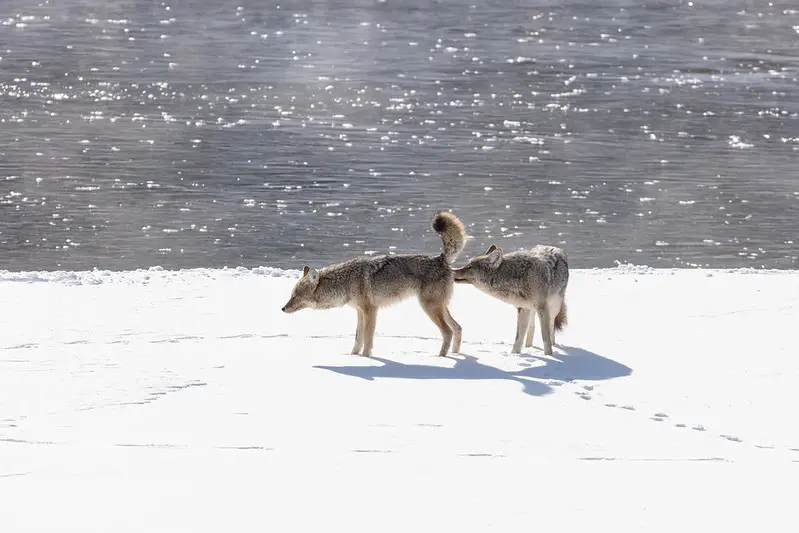
Act four: Now their eating our lunch!
Dinner is served! The last act always starts with a call like a rabbit in distress. Any small animal in pain will work, just let it run and run, but change the volume as much as you feel.
What’s going on now? For resident coyotes: They have let a trespasser claim a mate, take their land, and now eat their food. This has gone too far!
By now, your stand has gone on for long enough to bring in those coyotes too far away to hear your first series of calls. Transient coyotes, or even disinterested residents, now hear a dinner bell going off. Your best bet, make each coyote hunting stand last at least 45 minutes.
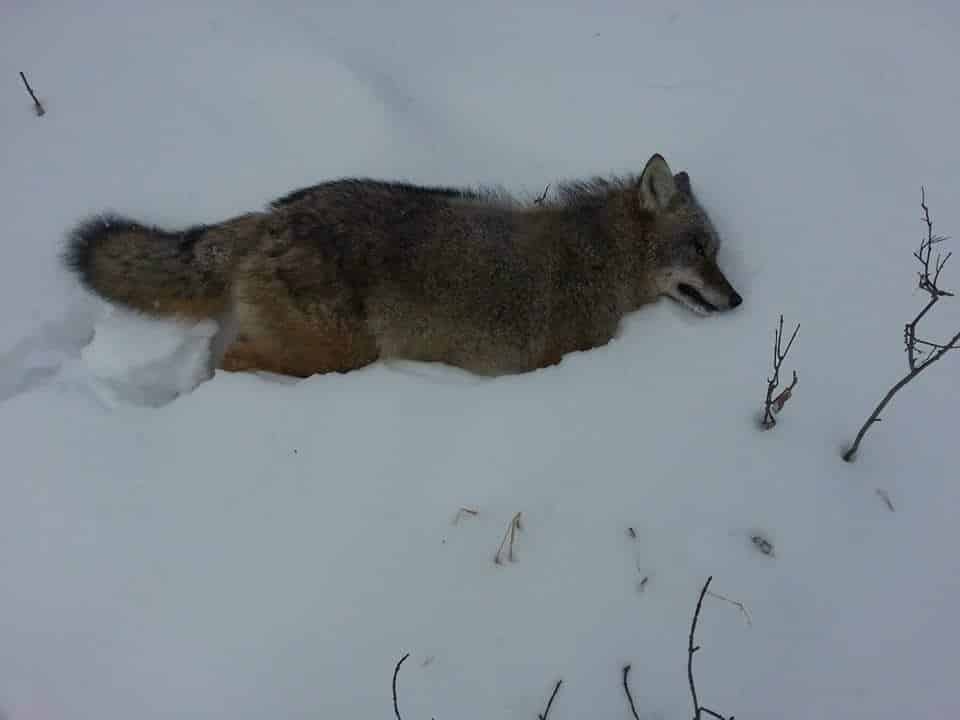
Coyote hunting in bad weather?
If you find this section interesting and want to read more about hunting coyotes in extreme weather, check out my article, The Truth About Predator Hunting In Bad Weather.
There are more google searches about coyote hunting in bad weather than rumors about new gun laws. “Do coyotes move in heavy rain?” “Is it too windy to hunt?” “Is a full moon good or bad for hunting coyotes?” “How long after a severe snowstorm should I wait?”
The answers you find, however, can vary wildly in usefulness and even truth. However, knowing the truth about hunting coyotes in bad weather can increase your hunting success rate more than a straight-shooting rifle.
Days of heavy rains, a foot or more of snowfall, or temperatures in single digits will both drive a predator into cover and then force it out into the elements.
The complete truth is you shouldn’t be just focusing on whether or not you’ll make a stand today based on the weather. Instead, use your local weather forecast to determine when and how long predators will be active before and after a weather event.
Coyotes notice impending severe weather and will try to grab a meal before a storm. The bad weather will then force a coyote into cover and, depending on the storm’s duration, determine how soon it can hunt again and hungry it will be after the storm.
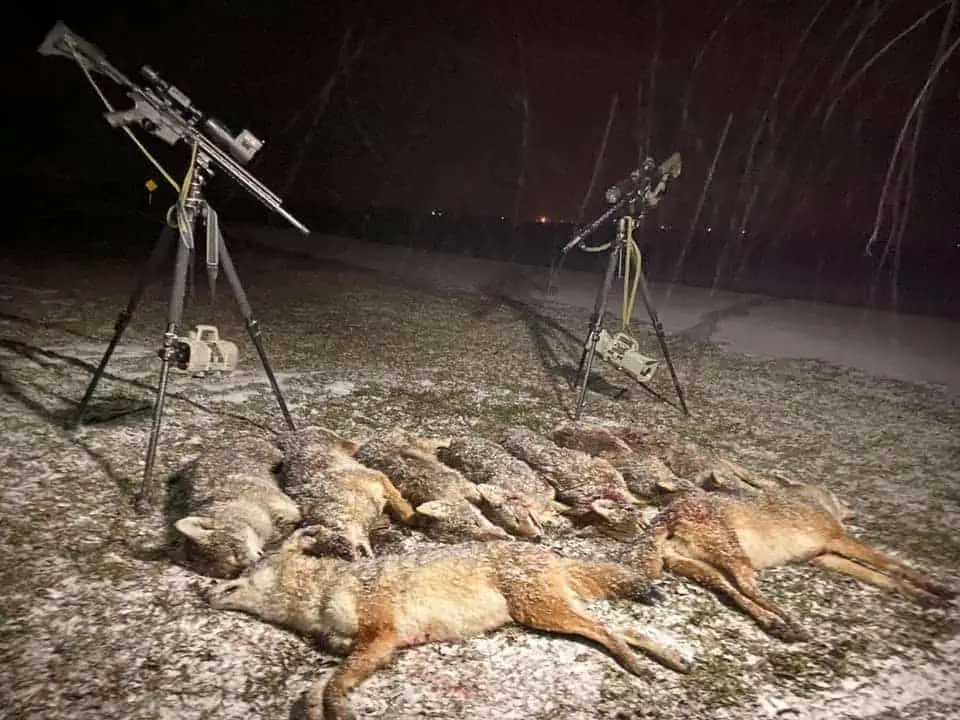
Hunting coyotes using barometric pressure.
Coyotes detect the approach of stormy weather by the changes in air pressure around them (barometric pressure). It’s a simple formula: The lower and faster barometric pressure drops, the sooner a storm’s arrival and the fiercer it will rage.
How barometric pressure affect coyotes.
When coyotes detect a sudden and sharp fall of barometric pressure, they instinctually alter their behavior. Coyotes know when severe weather is approaching, when it will arrive, and how bad things may get.
The coyote is an impressive predator and will not wait for the storm to begin. It will begin hunting for food right away. Why the sudden instinct to move? The barometric pressure provides a 12-hour window, not a three-day forecast.
You may not have a nose that detects barometric changes, but you can take advantage of an approaching storm. Be on stand twelve hours before the storm rages, and catch those hungry and anxious coyotes out hunting for their own supplies.
For the rest of your questions about temperature, rain, or coyote hunting in deep snow, check out the article referenced above.
Coyote hunting and shot placement.
For the full article on shot placement and ammo selection, read Guaranteed Dirt Naps: Best Place to Shoot a Coyote.
There are two critical parts of shooting a coyote and achieving a Dead Right There (DRT)outcome; making the coyote stop and stand still and knowing where to place your reticle.
How to stop a moving coyote.
The mere thought of making any noise when coyote hunting may seem foolish to a new coyote hunter, but at the right moment, it works.
Here are a few tricks to help you stop a moving coyote using a bark, whistle, lip smack, or woof To stop it, but still not scare it off.
- Use just enough volume to reach the coyote. You want to get its attention, not startle it.
- Raise the volume and keep trying to stop the coyote. Be prepared to have to issue several stop noises.
- If the coyote stops and starts moving before you can get your crosshairs on it, make more noise. Most dogs will stop several times, providing you with additional shooting opportunities.
- If the coyote spooks and starts fleeing the scene, rather than taking a wild shot, go crazy on your volume. A loud bark or woof may work, especially if the coyote thinks it has moved away from immediate danger.
Make sure you stop the coyote right where you want it and only when you are prepared to fire.
It works every time, day or night!
Where to aim at a coyote.
If you are a new coyote hunter, you probably asked a few people this question. How many answered your shot placement question with “Just behind the shoulder” or “Center mass”?
That’s bad advice, here’s the best advice.
Broadside: The best shot on a broadside coyote is to aim behind the shoulder joint, about 6” above the foreleg. If your bullet connects here, you’ll likely have a DRT coyote.
Facing forward: The aiming point on forwarding facing coyote can be the tip of the nose for long shots or the top of the head for even longer shots.
Quartering away. The quartering away shot is my favorite and produces some dramatic DRT results. I aim for directly behind the shoulder.
Quartering toward you: Shooting at a coyote quartering toward may look dicey, but there’s less risk of a splash against a bone, and you have a cleaner shot at the vital organs. Aim for the midpoint 6” above the top of the foreleg.
For more information don’t forget to read the full article listed above.
Hunting coyotes over a bait pile.
My complete article on the Secrets of the Perfect Coyote Bait Pile has much more information for you. Let’s look at a few critical points for hunting coyotes using bait.
Use the right bait.
Nothing works as well as a deer carcass. Coyotes expect to find dead of natural causes deer in the woods and fields. They even discover it split open and mangled alongside the roadway. They consume it regularly and are naturally drawn to the familiar odor of its decay. There may be other baits, and they may work, but deer meat is the superior choice.
The perfect location.
Whenever possible a coyote bait pile tucked just inside a woodline provides the coyote with a feeling of cover. When it has a shooting lane with you on the other end, you’ve mastered its location.
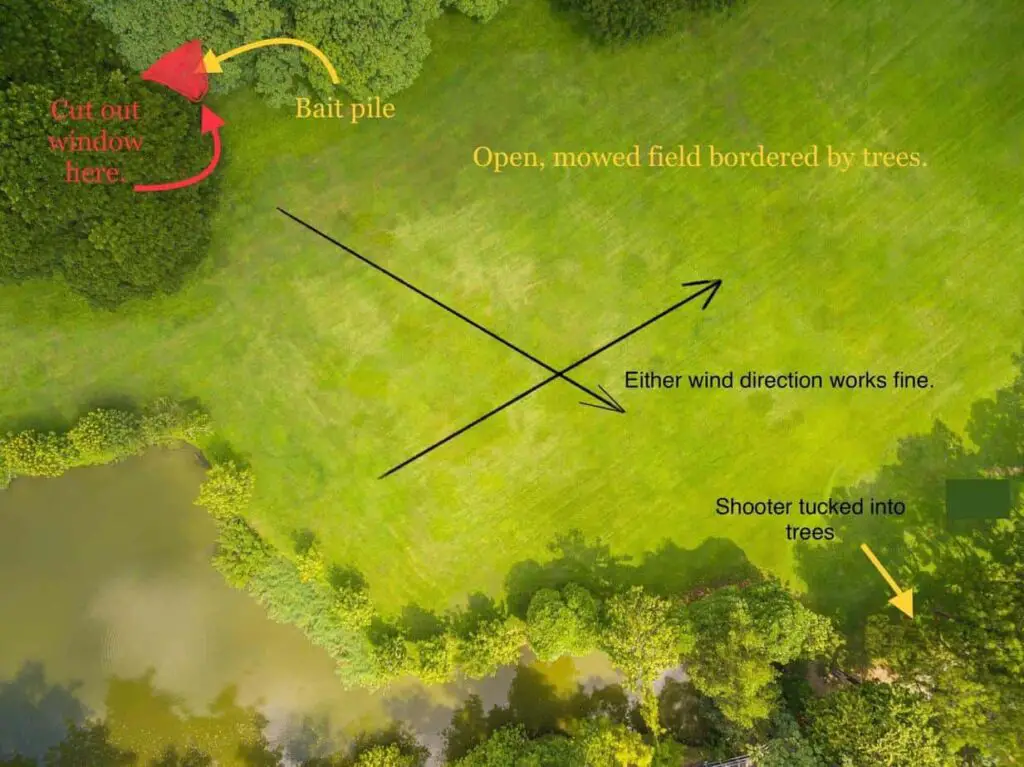
Now wait and don’t touch it.
The last piece of your perfect coyote bait pile is time. Time for the bait to ripen and time for coyotes to find the pile. This process may take days or weeks.
During this period, doubt will creep in and disturb your resolve. “Did I use enough deer meat?” “Is my bait pile too well hidden?”
As you walk away from your perfectly baited and placed pile, make a vow. A vow to never, for any reason, disturb it. This is a test of faith in yourself and the quality of your work.
Avoid the impulse to commit the only unforgivable sin of baiting coyotes: dousing a bait pile with fresh human scent.
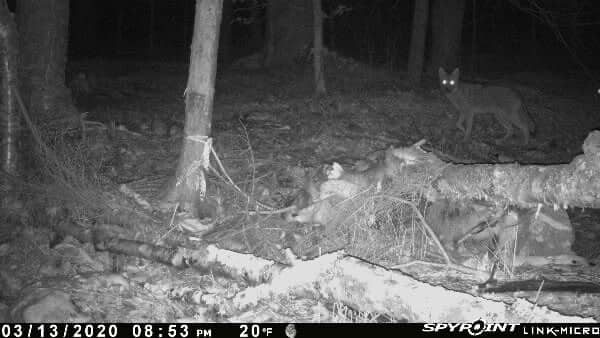
A few bait pile tricks when hunting coyotes.
Add a camera to your coyote bait pile.
A cellular game camera will tell you when your pile is being visited and, more importantly, by whom. A game camera can be used as a real-time burglar alarm or help you pattern the visits.
Calling near a coyote bait pile can increase your success.
Go ahead and call coyotes near your bait pile. Even if your stand ends up being dead, there’s a chance you’ll catch a late-arriving coyote. Coyotes that arrive late to your calls will sniff around and possibly discover your bait pile.
No matter which coyote bait pile method you use, scatter some morsels around the pile to help make the coyote feel more confident when reaching the actual pile.
Deer scraps are perfect, but confidence strips that include “fishy” smells, like shrimp, add a pleasing odor that has often set my bait piles on fire, luring predators in much quicker than deer-only sets. If you are afraid that coyotes won’t come to your bait pile because they’ve been shot at before, read my article, The Truth About Educated Coyotes.
If your coyote bait will be sitting in an area with heavy snow, use a coyote lure you can paste on tree limbs and stones that won’t get buried under the snow and ice.
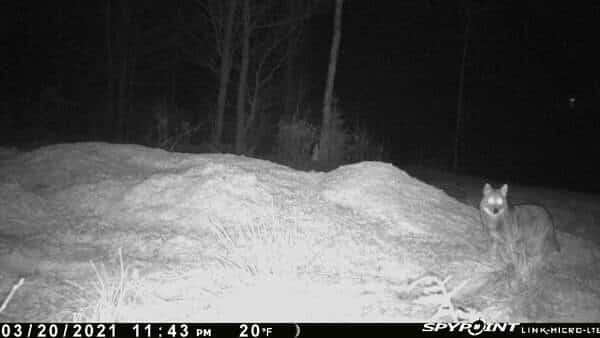
How to find a wounded coyote.
It will happen. You will watch a wounded coyote take off into the woods. Whether or not you ever recover that coyote will depend on how prepared your are, before you go hunting coyotes.
The good news? Most fatally wounded coyotes will be found within two hundred yards of where they were shot, leaving a visible blood trail for you to follow. After 200 yards, tracking a wounded coyote gets more challenging as the blood usually stops flowing, and you will need some basic tracking skills.
To track a wounded coyote, first note its reaction to being shot at.
The instant you shoot, the coyote will react in one of five possible ways. Here’s what each reaction could mean.
- If it runs away. You may have missed or had a round that failed to fragment and passed through without hitting a vital organ (pencil holed).
- The coyote spins in a circle. Your round hit somewhere behind the shoulder. The coyote is spinning as it tries to bite the source of pain.
- The dog Drops flat. This could be fatally wounded, knocked out, or momentarily paralyzed. Sometimes, a hit is instantly fatal and the dog collapses straight to the ground. But, a glancing blow to the skull can knock a coyote out for as long as 15 minutes. Another non-lethal injury is a round striking the neck. This can shock the spine and create a temporary paralysis. A coyote wounded in the neck could regain its senses within 5 minutes and run off.
- The target limps away. This could mean a paw, leg, or shoulder injury.
- The coyote just remains in the area. It may stare at you, run off a short distance and then turn back, or carry on as if nothing had happened. Your rifle-shot got the coyote’s attention, but did not cause any alarm. You’ll have just enough time to determine what went wrong with your shot and shoot again, because that coyote isn’t afraid of you.
When to take an immediate follow-up shot When coyote hunting
Reshoot the coyote immediately if:
- It is struggling to regain its feet or suffering.
- It was flattened but is now attempting to raise its head or stand back up.
- It stops spinning and lifts its head into the air. This dog is painfully wounded and is seeker out its tormentor’s location.
Tracking a coyote without blood evidence.
Why is a coyote that gets 200 yards away going to stop bleeding? In a word, clogging. This obstruction of blood loss is caused by a blockage of flesh, fat, intestines, or other body tissues.
Consider a stomach wound. The initial dark and watery blood will spill freely until a section of the intestine get sucked into the exit. With the wound “bandaged” less blood exits. Soon, it’s a few drops every 5-10 yards. Eventually, you’ll find no more blood unless or until the wound reopens.
If there is no exit wound, the body cavity may trap much of the blood. Until the cavity starts to overrun the edge of the wound, no more blood will fall to the ground.
After 200 yards, with what appears to be no other blood trail to follow, many coyote hunting newbies mistakenly believe their target “got away.”
Instead of quitting, however, you should admit that the wound did not magically heal itself. It’s just temporarily stopped flowing. The wound will reopen, and you will find the coyote—if you connect the dots between the last blood sign at 200 yards and where the injury resumes bleeding again.
If you have a blood light, now’s the time to use it. Remember, the ground and vegetation will be a dull grey, but the blood will glow an unmistakable red.
If you have a thermal device, you only need to flip it on and continue scanning ahead. Look for the heat of the coyote or check the ground for the warmer or colder than the background blood. If you can find neither, take the next step.
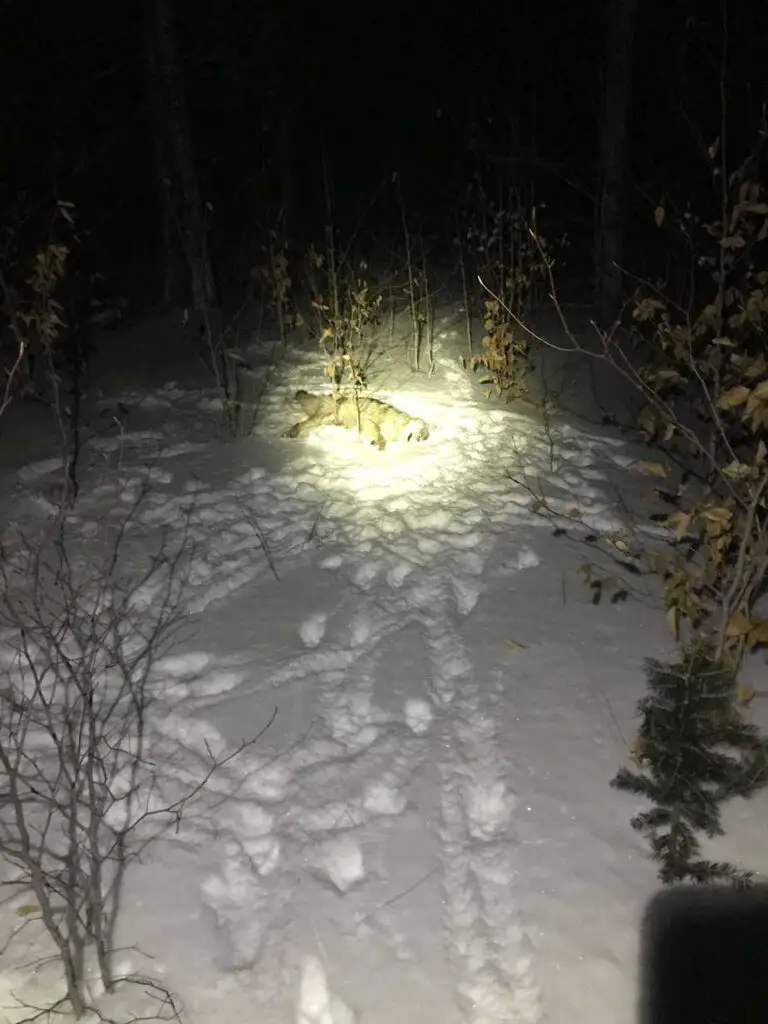
The hardest part of coyote hunting: Eye-tracking.
Start by getting on our hands and knees and begin eye tracking and slowly moving forward in the known direction the coyote was running. At this level, you will be forced to move slower, preserving evidence and getting near enough to it to notice specks of blood, recently disturbed rocks, and trampled leaves.
Take a good long look around every couple of minutes. Is there an area nearby with thick enough cover for a wounded coyote to bed down in? Is there a visible trail left on the leaves or grass that points out the path the animal took?
Flag all evidence. Scan with your blood light and thermal viewer.
Zigzag and hope for the worst; for the coyote, that is.
If you cannot find any more blood evidence or other physical proof, stand up and return to the last flagged bit of proof you found. Now, take a deep breath and relax for a few minutes.
Look, you know the wounded coyote did not just fly six inches above the ground, so there has to be some sign around.
The coyote had to be hauling add in a desperate attempt to escape. That coyote must have torn up some soil and left behind at least some paw prints, scuff marks, streak in the muds, or small pile of scattered leaves.
It may even be staggering around by now, slowing to a crawl. It could be slumped against a tree, checking back over its shoulder to see if anything is following it. Dying perhaps, if not already dead. It has to be somewhere close by.
Don’t give up until you have run out of energy, options, or daylight. This will be the hardest coyote you ever take, but one you will never forget. That is what makes coyote hunting one of the greatest hunting sports.
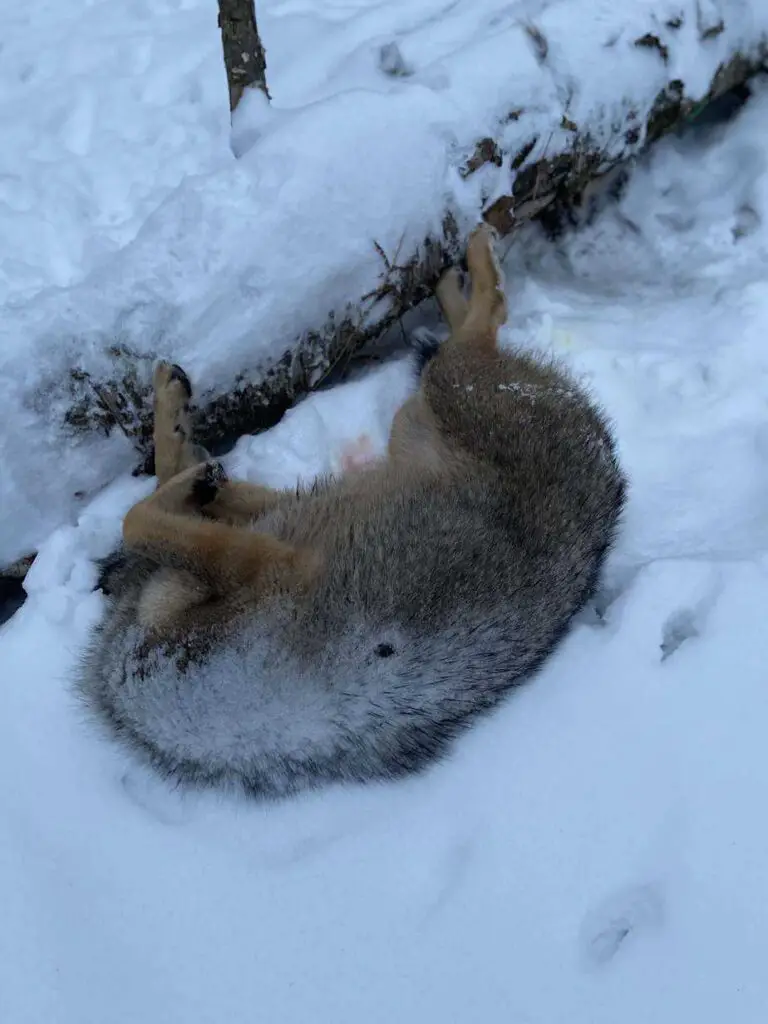
What are the best hours of the day to hunt coyotes?
I’m going to do a but of quoting here, shamelessly from my own article What’s the Best Time of Day to Coyote Hunt? and What’s the Best Time of Day to Coyote Hunt?
Best time of day to huntIng for coyotes in the Great Plains region.
The best studies of coyote activity in the Great Plains were done during combined seasons, resulting in two sets of data (mating/denning compared to pup rearing/ dispersal seasons).
The results, however, were nearly identical to those found studying eastern coyote activity.
Simply put, the best time of day to hunt coyotes in the Great Plains was at nighttime (an hour after dusk and an hour before dawn). Of course, dusk and dawn followed next, but daytime hunting (based on coyote activity) was, beyond a doubt, the worst time of the day to be coyote hunting.
Best time of day to hunt for coyotes in the Southwest.
Once again, in state and national parks, expect more daytime activity.
In rural and suburban areas, however, things look different in the Southwest. Studies here show coyote activity is split equally between day and night during the mating, denning, and pup dispersal seasons.
During pup rearing season, however, coyote activity was vastly greater during the nighttime.
Best time of day for hunting eastern coyotes during mating season.
- First place: Nighttime (between 5 p.m. and 6 a.m.). Nearly 80% of eastern coyotes will be on the move during these 13 hours.
- Second place: Dusk. 20% less activity than night.
- Third place: Dawn. 30% less activity than night.
- Last place: Daytime. 85% less activity during the day than during the night.
I hunt eastern coyotes. Here’s one taken during mating season at 3:30 in the morning. Note how unaffected the coyote was even after the first shot.
Best time of day for eastern coyote hunting during denning season.
- First place: Nighttime (between 7:30 p.m. and 0530 a.m.). 75% of eastern coyotes will be moving during these 12 hours.
- Second place: Dusk. 20% less activity than night.
- Third place: Dawn. 30% less activity than night.
- Last place: Daytime. 75% less activity during the day than during the night.
Best time of day for eastern coyote hunting during pup rearing season.
- First place: A three-way tie between nighttime, dusk, and dawn.
- Last place: Daytime. There’s 60% less coyote activity during the day than at any other time.
Best time of day to eastern coyote coyote during dispersal season.
- First place: Nighttime (between 6:00 p.m. and 6:00 a.m.). 80% of eastern coyotes are moving during these 12 hour hours.
- Second place: Dusk. 40% less activity than at night.
- Third place: Dawn: 50% less activity than at night.
- Last place: Daytime. Nearly 90% less activity than during the day.
In general, the best time to hunt coyotes is in the middle of the night in most places!
Some easy coyote hunting mistakes you can avoid.
Top Coyote Hunting Mistakes #1: Doubting yourself.
We all get what’s called “imposter syndrome.” That’s what it’s called when you doubt your abilities and feel like a fraud. It only lasts the first couple of stands. After that, you’ll get over it.
Top Coyote Hunting Mistakes # 2: Hunting with untested gear.
Everything you take to your stand must be tested, charged, sited, silenced, and operationally familiar to you.
Top Coyote Hunting Mistakes # 3: You alerted the coyotes.
To avoid being detected by coyotes at the very least try these:
- Don’t smoke after you’ve donned your camo.
- Park your vehicle far enough away so that it can’t be seen.
- From the moment your truck rolls to a stop, maintain absolute quiet.
- Sit with the wind in your face and call into the wind.
- Minimize all movements and stay in one place per stand location.
- Think of your hands as if they were large flags. Don’t wave them around for a coyote to spot as it’s coming to your call.
Top Coyote Hunting Mistakes # 4: You quit coyote hunting too soon.
Your mistake is thinking only in terms of your suffering. You’re cold, bored, and your butt hurts. You have a severe case of imposter syndrome. Three minutes into your first calling sequence, you start thinking you somehow screwed something up. You mentally quit, rationalize it with a lame reason, and as a result, you talk yourself into packing it in.
Five minutes after you have left, a coyote finally reaches your empty stand.
Fix it by committing to staying on stand for at least 30 minutes.
Top Coyote Hunting Mistakes # 5: You didn’t see the coyote.
You didn’t scan frequently enough while calling—and you blew it! YOU BLEW IT! Okay, happens to all of us. Just keep your eyes peeled for coyotes at all times.
Top Coyote Hunting Mistakes # 6: Shooting too soon.
Waiting to shoot may be the most challenging test you’ll have to pass, but shooting too soon, with a hammering heart, bellowing lungs, and an unsteady site picture? That’s going to result in a poor ending to your first successful calling session.
Let ‘em get as close as possible, get them to stop, and then slowly pull that trigger.
you are now ready to go coyote hunting!
So, go do some coyote hunting!

